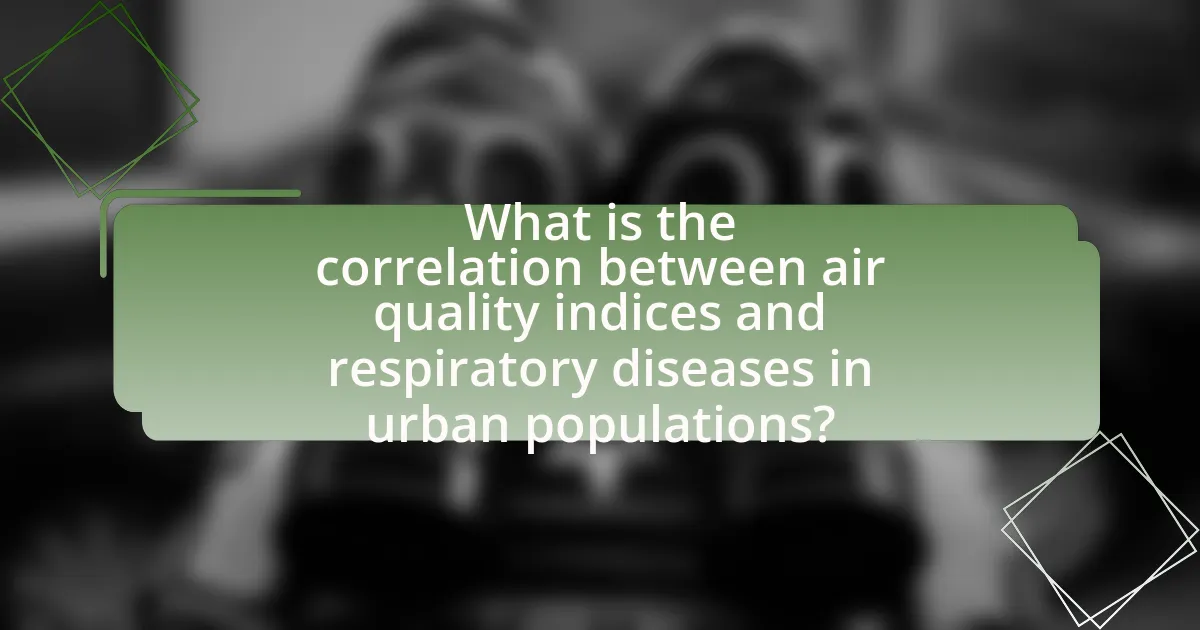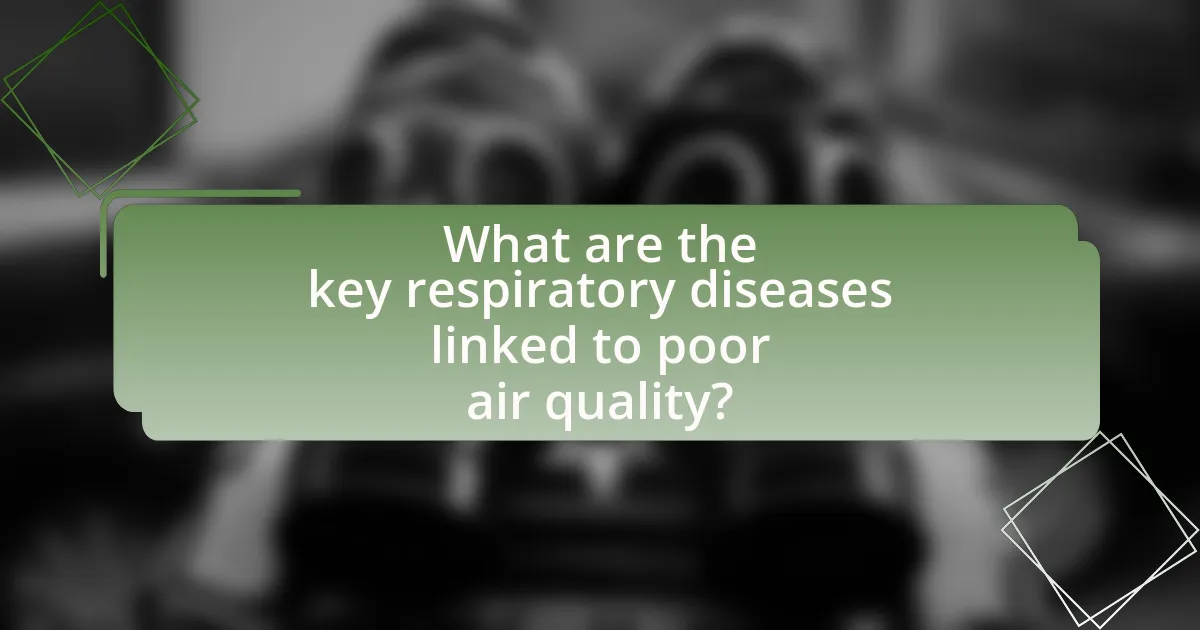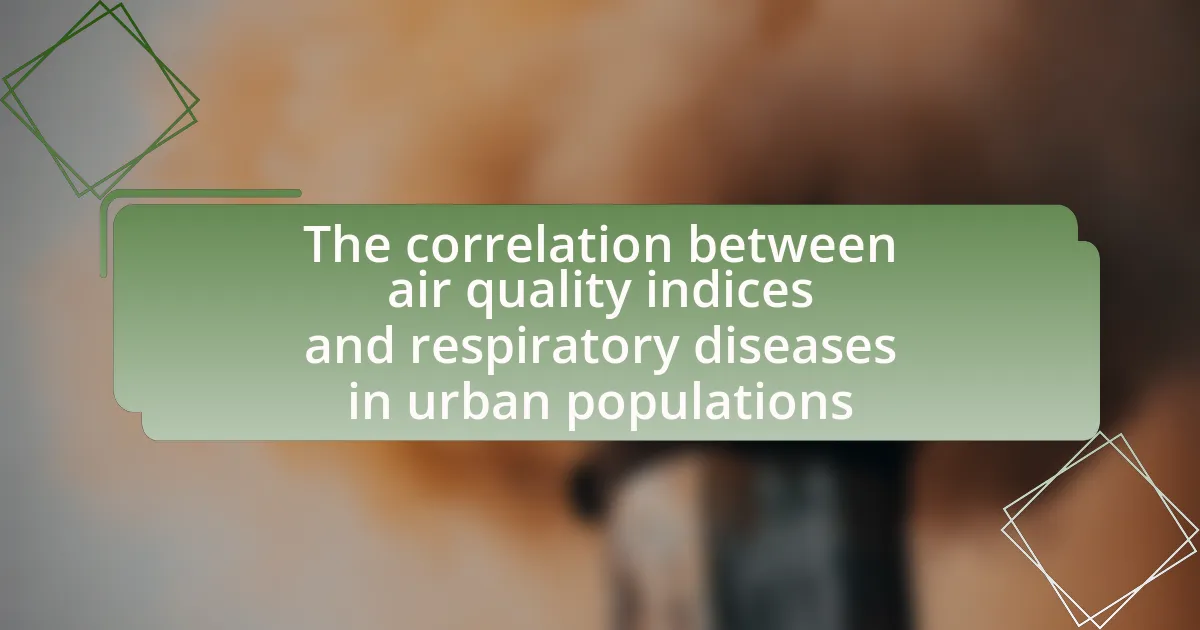The article examines the significant correlation between air quality indices and respiratory diseases in urban populations, highlighting how poor air quality is linked to increased rates of conditions such as asthma and chronic obstructive pulmonary disease (COPD). It details the measurement of air quality indices through ground-based monitoring stations and satellite data, identifying key pollutants like particulate matter, nitrogen dioxide, and ozone. The article also discusses the varying air quality across different urban environments, the impact of respiratory diseases on public health, and strategies for improving air quality management. Additionally, it emphasizes the importance of understanding this correlation for public health interventions and outlines practical steps individuals can take to protect their respiratory health in polluted urban areas.
What is the correlation between air quality indices and respiratory diseases in urban populations?

The correlation between air quality indices and respiratory diseases in urban populations is significant, with poorer air quality linked to higher rates of respiratory conditions. Studies indicate that elevated levels of pollutants such as particulate matter (PM2.5), nitrogen dioxide (NO2), and ozone (O3) are associated with increased hospital admissions for respiratory issues, including asthma and chronic obstructive pulmonary disease (COPD). For instance, research published in the journal “Environmental Health Perspectives” found that a 10 µg/m³ increase in PM2.5 was associated with a 7% increase in asthma hospitalizations among urban populations. This evidence underscores the direct impact of air quality on respiratory health, highlighting the need for effective air quality management in urban areas to mitigate health risks.
How are air quality indices measured in urban areas?
Air quality indices in urban areas are measured using a combination of ground-based monitoring stations and satellite data. Ground-based stations collect real-time data on pollutants such as particulate matter (PM2.5 and PM10), nitrogen dioxide (NO2), sulfur dioxide (SO2), carbon monoxide (CO), and ozone (O3). These measurements are then aggregated to calculate an overall air quality index, which typically ranges from good to hazardous based on established health guidelines. For instance, the U.S. Environmental Protection Agency (EPA) provides a standardized Air Quality Index (AQI) that categorizes air quality levels and their potential health effects. Satellite data complements ground measurements by providing broader spatial coverage and detecting pollutants over larger areas, enhancing the accuracy of air quality assessments in urban environments.
What specific pollutants are included in air quality indices?
Air quality indices typically include specific pollutants such as particulate matter (PM10 and PM2.5), nitrogen dioxide (NO2), sulfur dioxide (SO2), carbon monoxide (CO), ozone (O3), and volatile organic compounds (VOCs). These pollutants are measured because they have significant health impacts, particularly on respiratory diseases. For instance, PM2.5 is known to penetrate deep into the lungs and has been linked to increased rates of asthma and other respiratory conditions. Studies have shown that elevated levels of these pollutants correlate with higher incidences of respiratory diseases in urban populations, emphasizing the importance of monitoring air quality for public health.
How do air quality indices vary across different urban environments?
Air quality indices vary significantly across different urban environments due to factors such as population density, industrial activity, and transportation patterns. For instance, cities with high traffic congestion, like Los Angeles, often report elevated levels of nitrogen dioxide and particulate matter, leading to poorer air quality indices compared to cities with more green spaces and lower vehicle emissions, such as Portland. Studies indicate that urban areas with heavy industrial operations, like Houston, experience higher levels of volatile organic compounds, which negatively impact air quality indices. These variations directly correlate with respiratory disease prevalence, as populations in areas with poorer air quality indices face increased risks of conditions such as asthma and chronic obstructive pulmonary disease.
Why is understanding this correlation important for public health?
Understanding the correlation between air quality indices and respiratory diseases is crucial for public health because it informs policy decisions and health interventions aimed at reducing disease prevalence. Research indicates that poor air quality significantly contributes to respiratory conditions such as asthma and chronic obstructive pulmonary disease (COPD), with studies showing that a 10 µg/m³ increase in particulate matter can lead to a 1% increase in hospital admissions for respiratory issues. By recognizing this correlation, public health officials can implement targeted strategies to improve air quality, ultimately reducing the burden of respiratory diseases in urban populations.
What impact do respiratory diseases have on urban populations?
Respiratory diseases significantly affect urban populations by increasing morbidity and mortality rates. In densely populated areas, poor air quality, often characterized by high levels of pollutants such as particulate matter and nitrogen dioxide, exacerbates respiratory conditions like asthma and chronic obstructive pulmonary disease (COPD). Studies indicate that urban residents are more likely to experience respiratory symptoms and hospitalizations due to these diseases, with research showing that a 10 µg/m³ increase in particulate matter can lead to a 1% increase in respiratory-related hospital admissions. This correlation highlights the critical impact of environmental factors on public health in urban settings.
How can improved air quality indices lead to better health outcomes?
Improved air quality indices lead to better health outcomes by reducing the prevalence of respiratory diseases and enhancing overall public health. When air quality improves, levels of pollutants such as particulate matter, nitrogen dioxide, and sulfur dioxide decrease, which directly correlates with lower rates of asthma, chronic obstructive pulmonary disease (COPD), and other respiratory conditions. Studies have shown that cities with better air quality indices report significant declines in hospital admissions for respiratory issues; for instance, a study published in the journal Environmental Health Perspectives found that a 10 µg/m³ reduction in particulate matter was associated with a 1.5% decrease in respiratory hospitalizations. Thus, improved air quality not only mitigates health risks but also promotes a healthier urban environment.
What are the key respiratory diseases linked to poor air quality?

Key respiratory diseases linked to poor air quality include asthma, chronic obstructive pulmonary disease (COPD), and lung cancer. Asthma exacerbations are often triggered by pollutants such as particulate matter and ozone, leading to increased hospital visits and medication use. COPD, characterized by airflow limitation, is significantly worsened by long-term exposure to air pollutants, with studies indicating that individuals living in areas with high pollution levels have a higher prevalence of the disease. Lung cancer risk is also elevated in populations exposed to poor air quality, with research showing that fine particulate matter can contribute to the development of lung tumors.
Which respiratory diseases are most commonly associated with air pollution?
Chronic respiratory diseases most commonly associated with air pollution include asthma, chronic obstructive pulmonary disease (COPD), and lung cancer. Studies have shown that exposure to particulate matter and other pollutants significantly exacerbates asthma symptoms and increases the incidence of COPD. For instance, research published in the American Journal of Respiratory and Critical Care Medicine indicates that long-term exposure to air pollution is linked to a higher risk of developing lung cancer, particularly in urban populations where air quality is often compromised.
What are the symptoms and long-term effects of these diseases?
Respiratory diseases associated with poor air quality, such as asthma and chronic obstructive pulmonary disease (COPD), exhibit symptoms including persistent cough, wheezing, shortness of breath, and chest tightness. Long-term effects of these diseases can lead to decreased lung function, increased frequency of respiratory infections, and heightened risk of cardiovascular complications. Studies indicate that individuals exposed to high levels of air pollution are more likely to experience exacerbated symptoms and a decline in overall respiratory health, as evidenced by research published in the American Journal of Respiratory and Critical Care Medicine, which highlights the correlation between elevated particulate matter levels and increased hospital admissions for respiratory issues.
How do these diseases disproportionately affect certain demographics in urban areas?
Respiratory diseases disproportionately affect low-income and minority demographics in urban areas due to higher exposure to air pollution and limited access to healthcare. Studies indicate that neighborhoods with higher levels of air pollutants, such as particulate matter and nitrogen dioxide, often coincide with lower socioeconomic status, leading to increased rates of asthma and other respiratory conditions. For instance, the American Lung Association reports that African American and Hispanic populations experience higher asthma prevalence, with environmental factors like proximity to highways and industrial sites exacerbating their health outcomes.
How does exposure to air pollutants contribute to respiratory diseases?
Exposure to air pollutants significantly contributes to respiratory diseases by causing inflammation and damage to lung tissues. Pollutants such as particulate matter, nitrogen dioxide, and sulfur dioxide can penetrate deep into the respiratory system, leading to conditions like asthma, chronic obstructive pulmonary disease (COPD), and lung infections. Studies indicate that long-term exposure to high levels of air pollution is associated with a 20% increase in the risk of developing respiratory diseases, as reported by the World Health Organization. Additionally, research published in the journal “Environmental Health Perspectives” highlights that urban populations exposed to elevated air quality indices experience higher rates of respiratory hospitalizations, underscoring the direct link between air quality and respiratory health.
What biological mechanisms link air pollution to respiratory health issues?
Air pollution adversely affects respiratory health through several biological mechanisms, primarily involving inflammation, oxidative stress, and impaired lung function. Inhaled pollutants, such as particulate matter and gases, trigger an inflammatory response in the respiratory tract, leading to the release of pro-inflammatory cytokines. This inflammation can exacerbate conditions like asthma and chronic obstructive pulmonary disease (COPD).
Additionally, air pollutants generate reactive oxygen species, causing oxidative stress that damages lung tissue and disrupts normal cellular functions. This oxidative damage contributes to the progression of respiratory diseases by impairing the epithelial barrier and promoting fibrosis. Studies have shown that exposure to high levels of air pollution correlates with increased hospital admissions for respiratory issues, highlighting the direct impact of these biological mechanisms on public health.
How does the duration and intensity of exposure affect disease development?
The duration and intensity of exposure to pollutants significantly influence the development of respiratory diseases. Prolonged exposure to high levels of air pollutants, such as particulate matter and nitrogen dioxide, increases the risk of chronic respiratory conditions like asthma and chronic obstructive pulmonary disease (COPD). Studies have shown that individuals living in urban areas with poor air quality experience higher rates of respiratory illnesses, with research indicating that a 10 µg/m³ increase in particulate matter can lead to a 3% increase in hospital admissions for respiratory issues. This correlation underscores the critical role that both the length of exposure and the concentration of harmful substances play in the onset and progression of respiratory diseases.
What strategies can be implemented to mitigate the impact of air quality on respiratory health?

To mitigate the impact of air quality on respiratory health, implementing strategies such as improving urban planning, enhancing public transportation, and promoting green spaces is essential. Urban planning can reduce pollution sources by designing cities that minimize vehicle emissions and encourage walking and cycling. Enhancing public transportation reduces the number of cars on the road, thereby decreasing air pollutants. Additionally, promoting green spaces, such as parks and urban forests, can improve air quality by absorbing pollutants and providing cleaner air. Research indicates that cities with more green spaces have lower levels of particulate matter, which is linked to respiratory diseases. For instance, a study published in the journal “Environmental Health Perspectives” found that increased vegetation in urban areas is associated with reduced respiratory issues among residents.
What role do urban planning and policy play in improving air quality?
Urban planning and policy play a crucial role in improving air quality by implementing strategies that reduce pollution sources and promote sustainable practices. Effective urban planning can lead to the development of green spaces, which help absorb pollutants and improve air quality; for instance, cities with more parks and vegetation have been shown to have lower levels of particulate matter. Additionally, policies that encourage public transportation, cycling, and walking reduce reliance on cars, thereby decreasing emissions. Research indicates that cities with comprehensive air quality management plans, such as those adopted in London and Los Angeles, have successfully reduced air pollution levels, leading to better respiratory health outcomes in urban populations.
How can cities implement effective air quality management systems?
Cities can implement effective air quality management systems by establishing comprehensive monitoring networks that track pollutants and air quality indices in real-time. These systems should utilize advanced technologies such as low-cost sensors and satellite data to gather accurate information on air quality levels. For instance, cities like London and Los Angeles have successfully integrated such monitoring systems, which provide data that informs public health policies and regulatory measures. Additionally, cities can engage in public awareness campaigns to educate residents about air quality issues and promote behaviors that reduce pollution, such as using public transportation or adopting cleaner energy sources. Research indicates that cities with robust air quality management systems can significantly reduce respiratory diseases, as evidenced by a study published in the Journal of Environmental Health, which found a direct correlation between improved air quality and decreased hospital admissions for respiratory conditions.
What community initiatives can raise awareness about air quality and health?
Community initiatives that can raise awareness about air quality and health include educational workshops, community clean-up events, and air quality monitoring programs. Educational workshops can inform residents about the health impacts of poor air quality, supported by studies showing that urban populations experience higher rates of respiratory diseases linked to air pollution. Community clean-up events not only improve local environments but also foster community engagement and awareness of pollution sources. Air quality monitoring programs, which involve local residents in tracking pollution levels, provide real-time data that can be used to advocate for policy changes and promote healthier living conditions. These initiatives collectively empower communities to take action and improve public health outcomes related to air quality.
What practical steps can individuals take to protect their respiratory health in polluted urban areas?
Individuals can protect their respiratory health in polluted urban areas by minimizing outdoor exposure during high pollution days, using air purifiers indoors, and wearing masks designed to filter out particulate matter. Monitoring air quality indices, such as the Air Quality Index (AQI), allows individuals to plan outdoor activities when pollution levels are lower. Research indicates that prolonged exposure to high levels of air pollution is linked to respiratory diseases, emphasizing the importance of these protective measures.
How can individuals monitor air quality indices in their area?
Individuals can monitor air quality indices in their area by utilizing online platforms and mobile applications that provide real-time data on air quality. Websites such as AirNow and the World Air Quality Index project offer localized air quality information based on data from monitoring stations. Additionally, mobile apps like AQICN and Plume Labs’ Air Report allow users to receive alerts and updates on air quality levels specific to their location. These resources aggregate data from various sources, including government agencies and environmental organizations, ensuring accuracy and reliability in the information provided.
What lifestyle changes can reduce exposure to air pollutants?
To reduce exposure to air pollutants, individuals can adopt several lifestyle changes such as using air purifiers indoors, avoiding outdoor activities during high pollution days, and opting for public transportation or carpooling to decrease vehicle emissions. Research indicates that indoor air purifiers can significantly lower particulate matter levels, improving overall air quality within homes. Additionally, monitoring air quality indices can help individuals plan outdoor activities, as studies show that respiratory diseases are exacerbated by exposure to high levels of air pollution, particularly in urban areas. By making these changes, individuals can effectively minimize their exposure to harmful pollutants and potentially reduce the risk of respiratory issues.

Leave a Reply